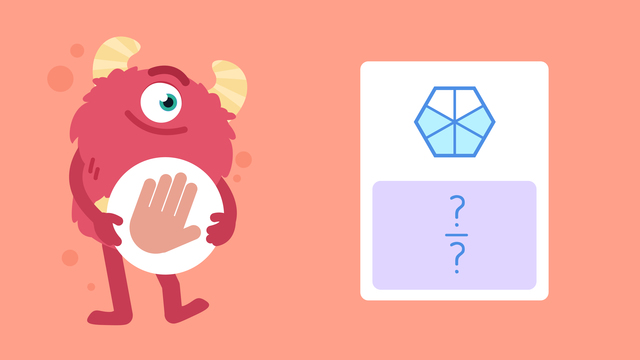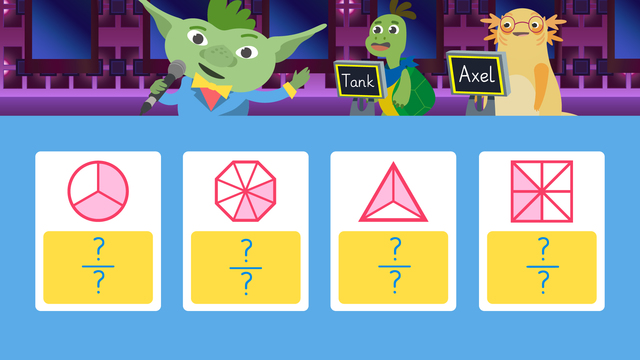Different Shapes, Same Fractions — Let's Practise!

Basics on the topic Different Shapes, Same Fractions — Let's Practise!
Join Razzi and compare different shapes that represent the same fraction.
Different Shapes, Same Fractions — Let's Practise! exercise
-
Which fraction do these shapes represent?
HintsHow many parts is the shape divided into? This is the denominator or bottom number of the fraction.
How many parts are shaded in? This is the numerator or top number of the fraction.
Both of these shapes are split into 4 equal parts and 1 part is shaded. That means they are representing the fraction $\frac{1}{4}$.
Solution- The heart and star represent $\mathbf{\frac{1}{2}}$ as they are split into 2 equal parts and 1 part is shaded in.
- The circle and triangle represent $\mathbf{\frac{2}{3}}$ as they are split into 3 equal parts and 2 parts are shaded in.
- The square and oval represent $\mathbf{\frac{3}{4}}$ as they are split into 4 equal parts and 3 parts are shaded in.
- The hexagon and rectangle represent $\mathbf{\frac{5}{6}}$ as they are split into 6 equal parts and 5 parts are shaded in.
-
Do these shapes represent the same fractions?
HintsCreate a fraction for each shape. The total number of parts is the denominator and the number of shaded parts is the numerator. Are the fractions the same?
Count all of the parts in each shape. Do they both have the same number of total parts?
Count the shaded parts in each shape. Do they both have the same number of shaded parts?
For example:
- The square has 2 parts and 1 part is shaded, so it represents the fraction $\frac{1}{2}$.
- The circle has 3 parts and 1 part is shaded, so it represents the fraction $\frac{1}{3}$.
- Therefore, these shapes do not represent the same fraction.
Solution- The circle and the pentagon did not represent the same fraction. The circle had 4 parts and 3 were shaded, so it represents the fraction $\frac{3}{4}$. The pentagon had 5 parts and 3 were shaded, so it represents the fraction $\frac{3}{5}$.
- The octagon and the square did represent the same fraction. They both had 8 parts and 5 were shaded, so represent the fraction $\frac{5}{8}$.
- The hexagon and the rectangle did represent the same fraction. They both had 6 parts and 2 were shaded, so represent the fraction $\frac{2}{6}$.
- The star and the pentagon did not represent the same fraction. The star had 5 parts and 3 were shaded, so it represents the fraction $\frac{3}{5}$. The pentagon had 5 parts and 4 were shaded, so it represents the fraction $\frac{4}{5}$.
-
Which fractions are these shapes representing?
HintsHow many total parts is the shape split into? This will be the denominator of your fraction.
How many parts are shaded? This will be the numerator of your fraction.
Remember, the numerator is the top number and the denominator is the bottom number. Here we can see a labelled example.
Solution- The triangle and rectangle represent $\mathbf{\frac{1}{3}}$ as they are split into 3 equal parts and 1 part is shaded in.
- The heptagon and circle represent $\mathbf{\frac{3}{7}}$ as they are split into 7 equal parts and 3 parts are shaded in.
- The rectangle and star represent $\mathbf{\frac{6}{10}}$ as they are split into 10 equal parts and 6 parts are shaded in. You could have also simplified this fraction to $\mathbf{\frac{3}{5}}$ by dividing both the numerator and denominator by two.
- The square and octagon represent $\mathbf{\frac{3}{8}}$ as they are split into 8 equal parts and 3 parts are shaded in.
-
Making different shapes with the same fractions.
HintsThe first gap asks you how many total parts the new shape would have. Count the number of total parts in the shape given.
The second gap asks you how many shaded parts the new shape would have. Count the number of shaded parts in the shape given.
For example, if we were going to draw a different shape that represented the same fraction, it would have 2 parts and 1 would be shaded.
Solution- The circle represents the fraction $\frac{4}{6}$ so if we drew a different shape representing the same fraction, it would have 6 parts in total and 4 would be shaded. Therefore, the fraction would have a numerator of 4 and a denominator of 6.
- The rectangle represents the fraction $\frac{5}{9}$ so if we drew a different shape representing the same fraction, it would have 9 parts in total and 5 would be shaded. Therefore, the fraction would have a numerator of 5 and a denominator of 9.
- The pentagon represents the fraction $\frac{1}{5}$ so if we drew a different shape representing the same fraction, it would have 5 parts in total and 1 would be shaded. Therefore, the fraction would have a numerator of 1 and a denominator of 5.
- The octagon represents the fraction $\frac{1}{8}$ so if we drew a different shape representing the same fraction, it would have 8 parts in total and 1 would be shaded. Therefore, the fraction would have a numerator of 1 and a denominator of 8.
-
Which fraction do these shapes represent?
HintsHow many parts does each shape have in total? This is the denominator, or bottom number, of the fraction.
How many parts are shaded in each shape? This is the numerator, or top number, of the fraction.
Here is another shape that represents the same fraction. There are 4 parts altogether and 1 part is shaded.
SolutionThese shapes represent the fraction $\mathbf{\frac{1}{4}}$.
They all have 4 parts with 1 part shaded.
-
The Cake Sale.
HintsTo find out how many slices there were to start with, look at the denominator of the fraction.
The numerator of the fraction tells us how many slices are left. To find out how many were sold, you need to subtract the numerator from the denominator.
Have a go at drawing a shape to match the fraction. Shade in the slices left. How many unshaded parts do you have?
For example, this circle represents another cake that had $\frac{1}{4}$ left. A shape has been drawn with 4 parts and 1 has been shaded in. We can now count 3 unshaded parts. That means 3 slices were sold.
SolutionAt the end of the sale the sponge cake and the lemon cake both represented the same fraction: $\frac{3}{10}$. That means there were 10 slices to start with and 7 were sold. Above we can see an image representing these two cakes.
- The denominator of the fraction is 10 so that means there were 10 slices to start with.
- There were 3 slices left. If we subtract 3 from 10 we get 7, so that means 7 slices were sold.
The chocolate cake and the carrot cake both represented the fraction $\frac{2}{9}$. That means there were 9 slices to start with and 7 were sold.
- The denominator of the fraction is 9 so that means there were 9 slices to start with.
- There were 2 slices left. If we subtract 2 from 9 we get 7, so that means 7 slices were sold.
The red velvet cake and the ginger cake both represented the fraction $\frac{2}{12}$. That means there were 12 slices to start with and 10 were sold.
- The denominator of the fraction is 12 so that means there were 12 slices to start with.
- There were 2 slices left. If we subtract 2 from 12 we get 10, so that means 10 slices were sold.


 Do you want to learn faster and more easily?
Do you want to learn faster and more easily?







